Home / Epoxide Ring Opening With Base
Alcohols, Epoxides and Ethers
Epoxide Ring Opening With Base
Last updated: April 18th, 2025 |
Ring-opening of epoxides with basic nucleophiles
- Epoxides are cyclic ethers with considerable ring strain (about 13 kcal/mol)
- Epoxides undergo reaction with nucleophiles under basic conditions at the least substituted end of the epoxide
- If a chiral center is at this carbon, its stereochemistry will be inverted.
- Nucleophiles that will add to epoxides include hydroxide ion (HO-) alkoxides, Grignard reagents, organolithium reagents, and LiAlH4 (among others)
- A simple way to remember this is to think of epoxide opening under basic conditions as proceeding much like an SN2 reaction.
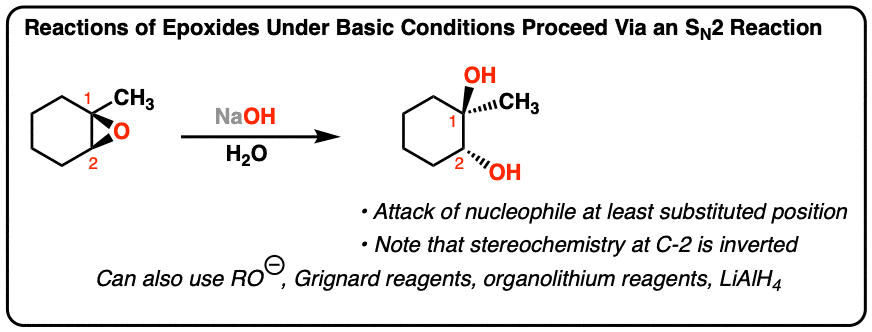
Table of Contents:
- Opening Epoxides With Base: How it Works
- The Role of Solvent
- Understanding Separate Quench Steps: 1) Add this 2) THEN add this!
- What Doesn’t Work: Poor Nucleophiles
- Notes
- Quiz Yourself!
- (Advanced) References and Further Reading
1. Opening Epoxides With Base: How It Works
In the last post we discussed the reactions of epoxides under acidic conditions and saw how they resembled the “3-membered ring” family of alkene mechanisms. We left off by noting that the reaction of the epoxide (shown above) with NaOH in H2O gave a different product than that obtained through H3O+. Therefore it must go through a different mechanism.
Our question is, how does this reaction work?
Noting the fact that the nucleophile (HO- ) attacks the epoxide at the least substituted position (C2) and results in inversion of stereochemistry at this position, our best evidence is consistent with this reaction proceeding through the familiar SN2 mechanism followed by a transfer of proton from the weakly acidic solvent (H2O) to the alkoxide (RO – ) providing a neutral alcohol.
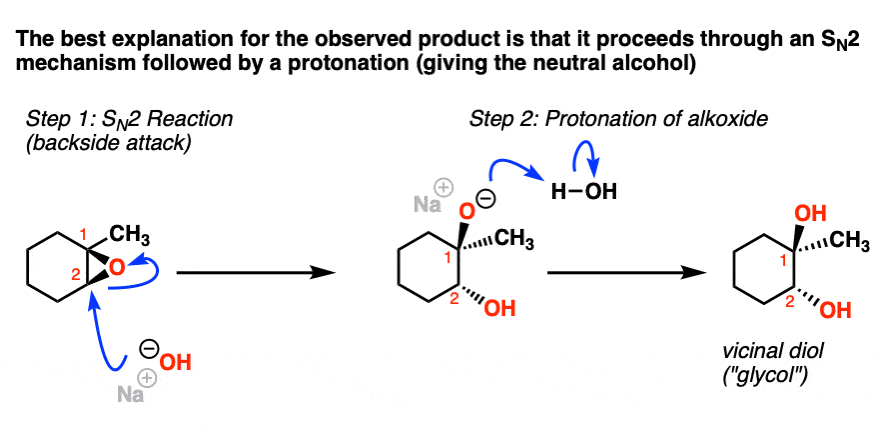
Along the same lines, if epoxides are treated with alkoxides (RO- ) in alcohol solvent, they lead to essentially the same reaction. Here’s an example with NaOCH3. Note that the proton must come from CH3OH here.
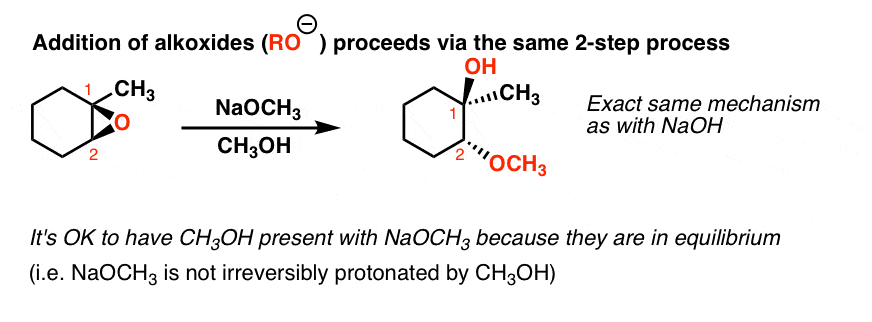
2. The Role Of Solvent
Now – at the end of the last post, we mentioned that acids are incompatible with some strong nucleophiles because they will be destroyed by irreversible protonation [classic example: Grignard reagents and water]. Should we be worried about NaOH in H2O or NaOCH3 in CH3OH? No! These are examples of bases in equilibrium with their conjugate acids.
It’s fine to have NaOH in the same reaction vessel with H2O since the reaction is reversible.

However, if we move to more strongly basic nucleophiles, such as Grignard reagents (RMgX), organolithium reagents (R-Li) or hydrides (H-) we should be concerned, because the conjugate acids of each of these species (pKa of about 50 for alkanes, and about 38 for H2) are much weaker acids than ROH (pKa 16-18).
[A good rule of thumb for “reversibility” of an acid base reaction is a pKa difference of 8 or less – see A Handy Rule of Thumb for Acid-Base Reactions].
That means that if these strong bases come into contact with ROH, an irreversible acid-base reaction will occur. We thus obtain an alkoxide (RO-) which is insufficient in strength to deprotonate alkanes or H2.

Bye-bye nucleophile!
3. Understanding Separate Quench Steps: 1) Add this 2) THEN, add this!
What this means in practice is that we just move the protonation step to the end, in a process sometimes called a “quench”. Note how each of the following reactions has a Step 1) and a Step 2).
Step 1 is addition of nucleophile. After the reaction is done, we add our source of proton (Step 2) to quench. Note that there are many reagents commonly written for this process – H2O, H3O+, H+, NH4Cl, “acid workup” just to name a few. They all mean the same thing!
Here are some examples of reactions of epoxides with strongly basic nucleophiles. Grignard reagents , organolithium reagents, and hydride (e.g. LiAlH4 , a source of H- ).
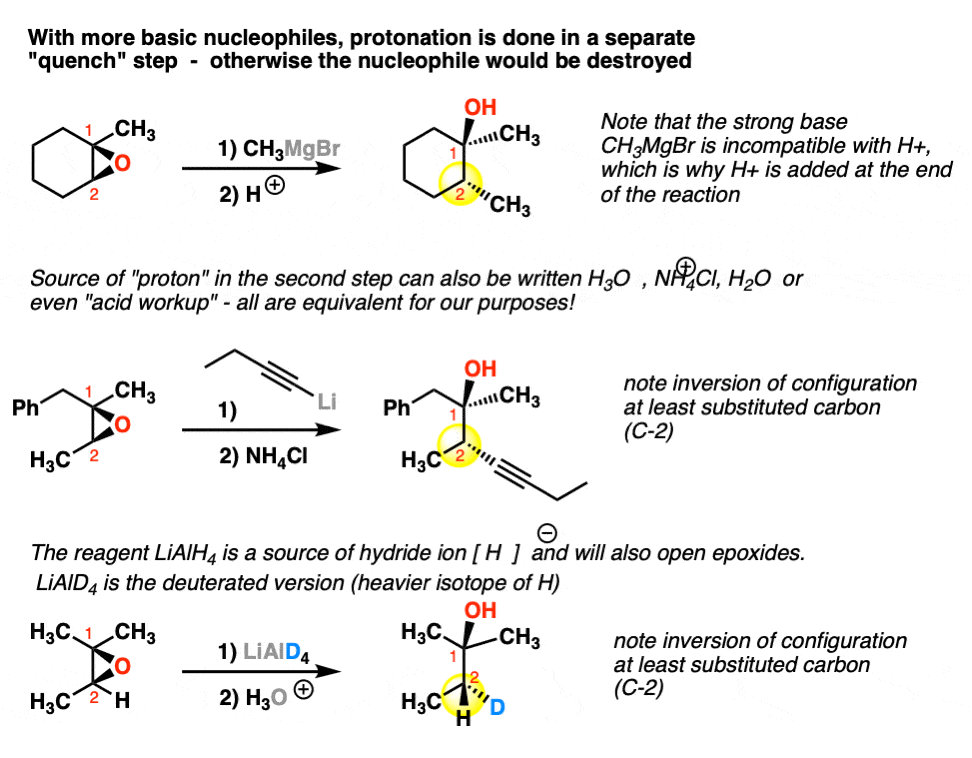
Is there anything else? [yes – there are other nucleophiles which will react with epoxides, but they are seldom seen at this level. However I have added them in Note 1 at the bottom].
4. What Doesn’t Work: Poor Nucleophiles
Just like any SN2 reaction, for this pathway to work, we really must be dealing with a decent nucleophile. Poor nucleophiles, especially neutral species like H2O, ROH, and RCOOH simply won’t cut it.
In order for epoxides to react we need either to use strongly acidic conditions (good for weak nucleophiles) or basic conditions (HO- , RO- , RMgBr, RLi, LiAlH4).

This concludes our exploration of epoxides and ethers. However we still have a lot to talk about regarding alcohols – and certainly we aren’t done with examples of SN1 and SN2 reactions. That’s coming up next.
Next Post – Making Alkyl Halides From Alcohols
Notes
Related Articles
Note 1. Some other nucleophiles which react with epoxides but are rarely seen in introductory organic chemistry. Note that the second and third examples don’t show the source of proton (H+) that adds to the oxygen, but it can be added afterwards in a “quench” step.
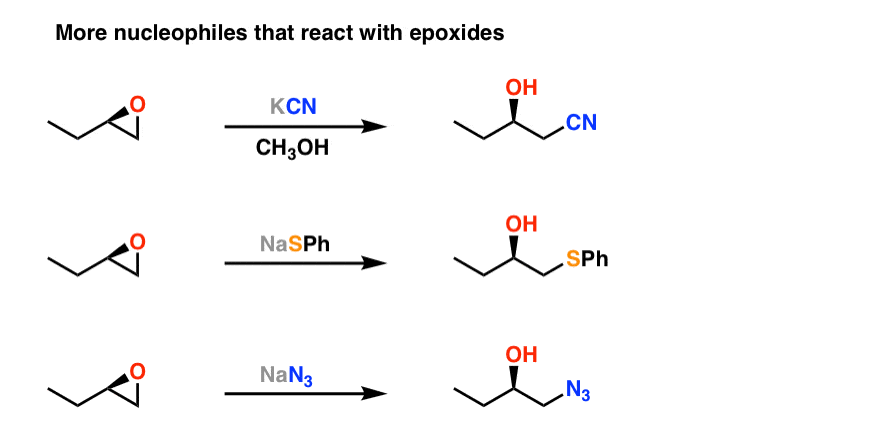
Quiz Yourself!

Become a MOC member to see the clickable quiz with answers on the back.
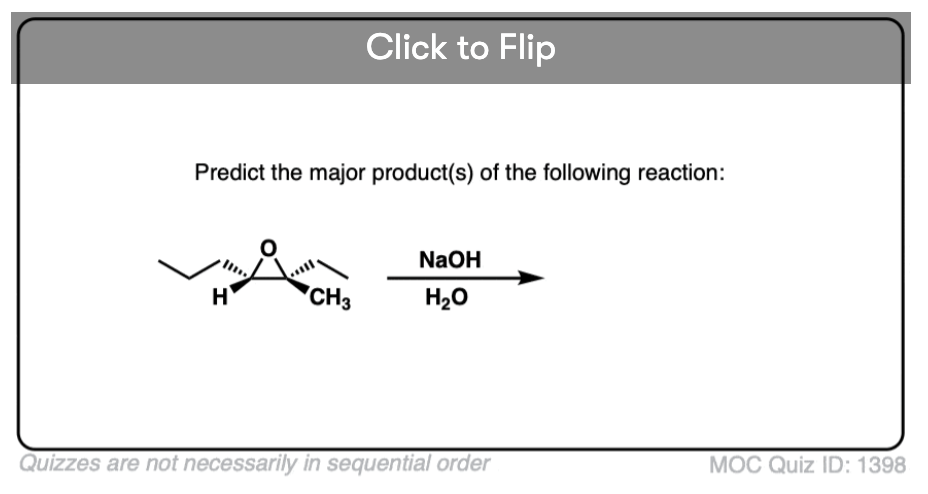
Become a MOC member to see the clickable quiz with answers on the back.
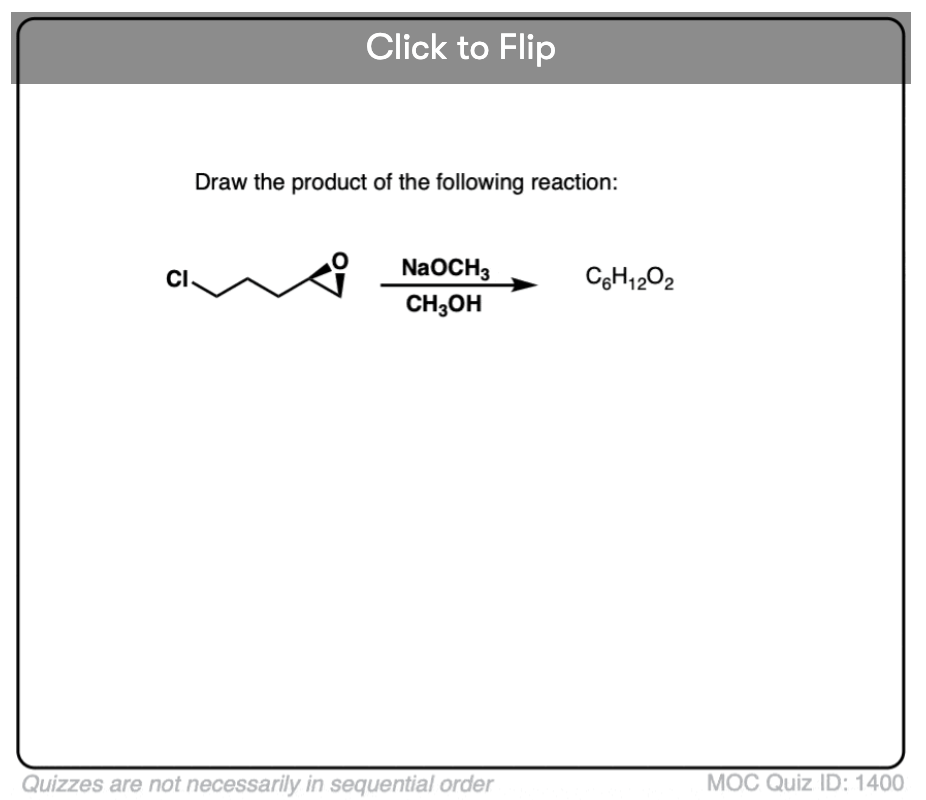
Become a MOC member to see the clickable quiz with answers on the back.
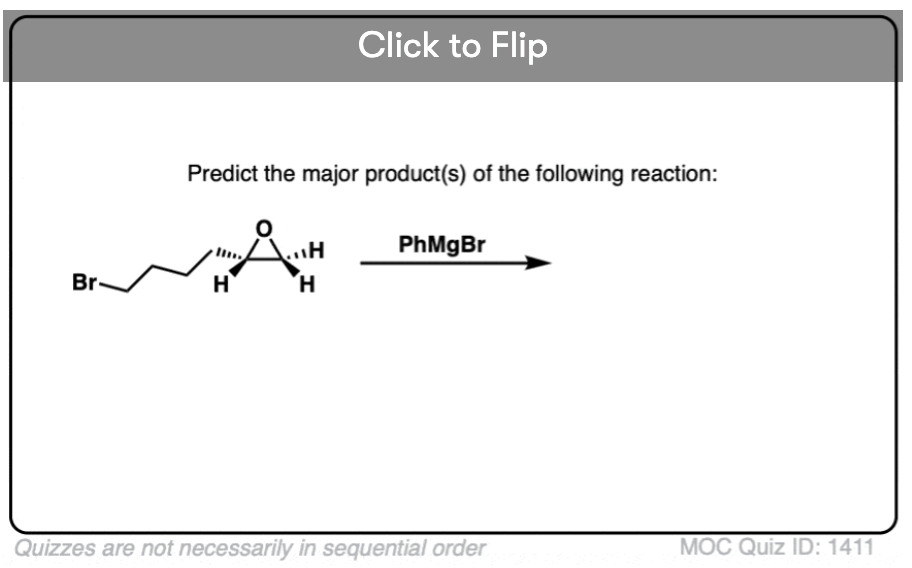
Become a MOC member to see the clickable quiz with answers on the back.
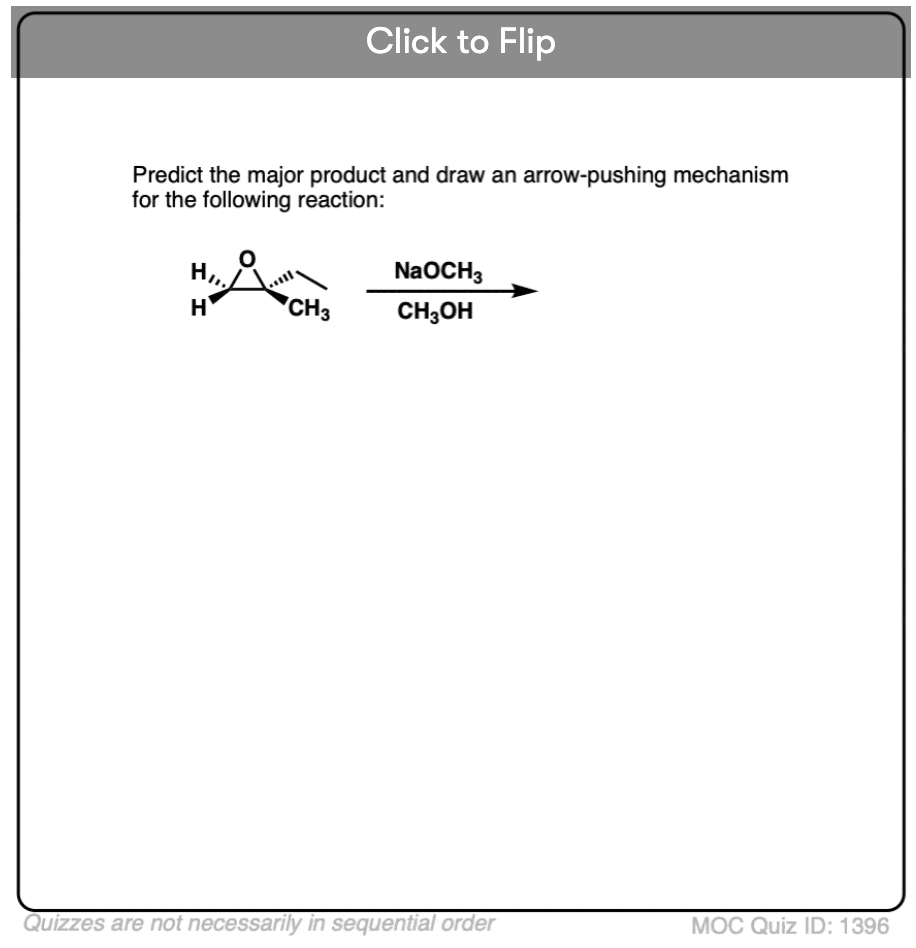
Become a MOC member to see the clickable quiz with answers on the back.
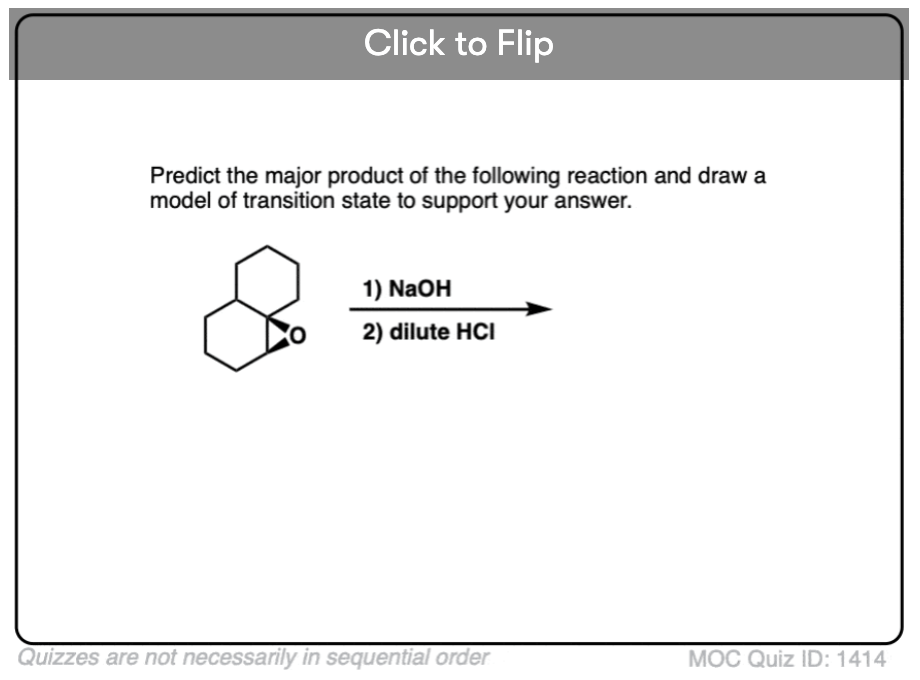
Become a MOC member to see the clickable quiz with answers on the back.
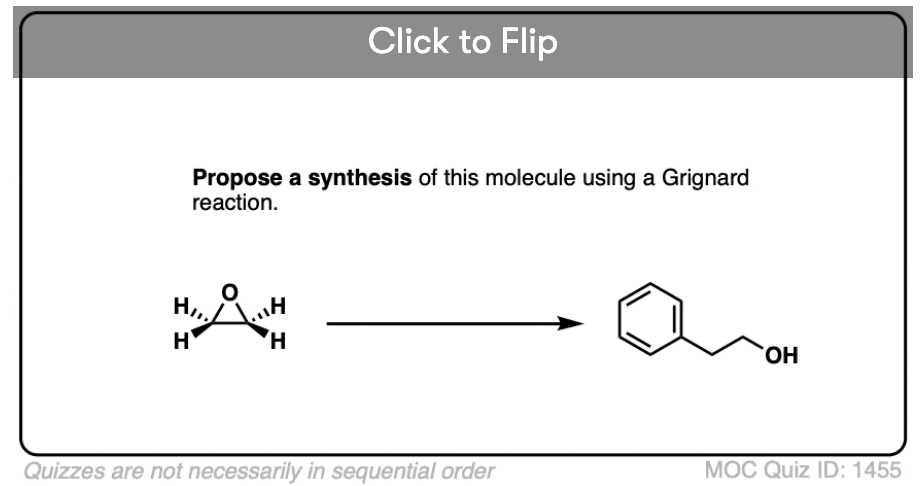
Become a MOC member to see the clickable quiz with answers on the back.
(Advanced) References and Further Reading
- —The velocities of combination of sodium derivatives of phenols with olefine oxides
David Runciman Boyd and Ernest Robert Marle
J. Chem. Soc., Trans., 1914, 105, 2117-2139
DOI: 10.1039/CT9140502117
This and the accompanying paper are early examples of ring-opening of epoxides with alkoxides. - —The velocities of combination of sodium derivatives of phenols with olefine oxides. Part II
David Runciman Boyd and Miss Doris Feltham Thomas
J. Chem. Soc., Trans., 1919, 115, 1239-1243
DOI: 10.1039/CT9191501239 - CYCLOHEXENE IMINE
Iain D. G. Watson, Nicholas Afagh, and Andrei K. Yudin
Org. Synth. 2010, 87, 161
DOI: 10.15227/orgsyn.087.0161
The first reaction in this procedure from Organic Syntheses is the ring-opening of cyclohexene oxide with sodium azide. As Prof. Yudin shows, this reaction is a useful precursor for the synthesis of N-H aziridines, the nitrogen analog of epoxides. - The Reaction of Dimethylmagnesium and of Diethylmagnesium with Cyclohexene Oxide
Paul D. Bartlett and C. Manly BerryJournal of the American Chemical Society 1934 56 (12), 2683-2685DOI: 10.1021/ja01327a045This is an early example of ring-opening of epoxides with Grignard reagents.
- The stereochemical course of epoxide ring opening by allylic grignard reagents
Hugh Felkin, Georges Roussi
Tetrahedron Lett. 1965, 6 (46), 4153-4159
DOI: 10.1016/S0040-4039(01)99581-4
This is a more advanced (and perhaps less relevant) paper, attempting to resolve whether allylic Gringard reagents go through an SN2’ reaction. This could be resolved easily with isotopic labeling and 13C NMR. - Acid- and base-catalyzed ring-opening reactions or a sterically hindered epoxide
Herbert Mayr, Rainer Koschinsky, Elfriede Will, and Englbert Bauml
The Journal of Organic Chemistry 1987, 52 (7), 1342-1344
DOI: 1021/jo00383a033
A nice paper describing the different products obtained when opening a hindered epoxide under acidic vs. basic conditions. Prof. Mayr (LMU, Germany) is well known for his extremely rigorous work in physical organic chemistry, where he has developed scales for quantifying electrophilicity and nucleophilicity.
00 General Chemistry Review
01 Bonding, Structure, and Resonance
- How Do We Know Methane (CH4) Is Tetrahedral?
- Hybrid Orbitals and Hybridization
- How To Determine Hybridization: A Shortcut
- Orbital Hybridization And Bond Strengths
- Sigma bonds come in six varieties: Pi bonds come in one
- Dipole Moments and Dipoles
- A Key Skill: How to Calculate Formal Charge
- The Four Intermolecular Forces and How They Affect Boiling Points
- 3 Trends That Affect Boiling Points
- How To Use Electronegativity To Determine Electron Density (and why NOT to trust formal charge)
- Introduction to Resonance
- How To Use Curved Arrows To Interchange Resonance Forms
- Evaluating Resonance Forms (1) - The Rule of Least Charges
- How To Find The Best Resonance Structure By Applying Electronegativity
- Evaluating Resonance Structures With Negative Charges
- Evaluating Resonance Structures With Positive Charge
- Exploring Resonance: Pi-Donation
- Exploring Resonance: Pi-acceptors
- In Summary: Evaluating Resonance Structures
- Drawing Resonance Structures: 3 Common Mistakes To Avoid
- How to apply electronegativity and resonance to understand reactivity
- Bond Hybridization Practice
- Structure and Bonding Practice Quizzes
- Resonance Structures Practice
02 Acid Base Reactions
- Introduction to Acid-Base Reactions
- Acid Base Reactions In Organic Chemistry
- The Stronger The Acid, The Weaker The Conjugate Base
- Walkthrough of Acid-Base Reactions (3) - Acidity Trends
- Five Key Factors That Influence Acidity
- Acid-Base Reactions: Introducing Ka and pKa
- How to Use a pKa Table
- The pKa Table Is Your Friend
- A Handy Rule of Thumb for Acid-Base Reactions
- Acid Base Reactions Are Fast
- pKa Values Span 60 Orders Of Magnitude
- How Protonation and Deprotonation Affect Reactivity
- Acid Base Practice Problems
03 Alkanes and Nomenclature
- Meet the (Most Important) Functional Groups
- Condensed Formulas: Deciphering What the Brackets Mean
- Hidden Hydrogens, Hidden Lone Pairs, Hidden Counterions
- Don't Be Futyl, Learn The Butyls
- Primary, Secondary, Tertiary, Quaternary In Organic Chemistry
- Branching, and Its Affect On Melting and Boiling Points
- The Many, Many Ways of Drawing Butane
- Wedge And Dash Convention For Tetrahedral Carbon
- Common Mistakes in Organic Chemistry: Pentavalent Carbon
- Table of Functional Group Priorities for Nomenclature
- Summary Sheet - Alkane Nomenclature
- Organic Chemistry IUPAC Nomenclature Demystified With A Simple Puzzle Piece Approach
- Boiling Point Quizzes
- Organic Chemistry Nomenclature Quizzes
04 Conformations and Cycloalkanes
- Staggered vs Eclipsed Conformations of Ethane
- Conformational Isomers of Propane
- Newman Projection of Butane (and Gauche Conformation)
- Introduction to Cycloalkanes
- Geometric Isomers In Small Rings: Cis And Trans Cycloalkanes
- Calculation of Ring Strain In Cycloalkanes
- Cycloalkanes - Ring Strain In Cyclopropane And Cyclobutane
- Cyclohexane Conformations
- Cyclohexane Chair Conformation: An Aerial Tour
- How To Draw The Cyclohexane Chair Conformation
- The Cyclohexane Chair Flip
- The Cyclohexane Chair Flip - Energy Diagram
- Substituted Cyclohexanes - Axial vs Equatorial
- Ranking The Bulkiness Of Substituents On Cyclohexanes: "A-Values"
- Cyclohexane Chair Conformation Stability: Which One Is Lower Energy?
- Fused Rings - Cis-Decalin and Trans-Decalin
- Naming Bicyclic Compounds - Fused, Bridged, and Spiro
- Bredt's Rule (And Summary of Cycloalkanes)
- Newman Projection Practice
- Cycloalkanes Practice Problems
05 A Primer On Organic Reactions
- The Most Important Question To Ask When Learning a New Reaction
- Curved Arrows (for reactions)
- Nucleophiles and Electrophiles
- The Three Classes of Nucleophiles
- Nucleophilicity vs. Basicity
- What Makes A Good Nucleophile?
- What Makes A Good Leaving Group?
- 3 Factors That Stabilize Carbocations
- Equilibrium and Energy Relationships
- 7 Factors that stabilize negative charge in organic chemistry
- 7 Factors That Stabilize Positive Charge in Organic Chemistry
- What's a Transition State?
- Hammond's Postulate
- Learning Organic Chemistry Reactions: A Checklist (PDF)
- Introduction to Oxidative Cleavage Reactions
06 Free Radical Reactions
- Free Radical Reactions
- 3 Factors That Stabilize Free Radicals
- Bond Strengths And Radical Stability
- Free Radical Initiation: Why Is "Light" Or "Heat" Required?
- Initiation, Propagation, Termination
- Monochlorination Products Of Propane, Pentane, And Other Alkanes
- Selectivity In Free Radical Reactions
- Selectivity in Free Radical Reactions: Bromination vs. Chlorination
- Halogenation At Tiffany's
- Allylic Bromination
- Bonus Topic: Allylic Rearrangements
- In Summary: Free Radicals
- Synthesis (2) - Reactions of Alkanes
- Free Radicals Practice Quizzes
07 Stereochemistry and Chirality
- Types of Isomers: Constitutional Isomers, Stereoisomers, Enantiomers, and Diastereomers
- How To Draw The Enantiomer Of A Chiral Molecule
- How To Draw A Bond Rotation
- Introduction to Assigning (R) and (S): The Cahn-Ingold-Prelog Rules
- Assigning Cahn-Ingold-Prelog (CIP) Priorities (2) - The Method of Dots
- Enantiomers vs Diastereomers vs The Same? Two Methods For Solving Problems
- Assigning R/S To Newman Projections (And Converting Newman To Line Diagrams)
- How To Determine R and S Configurations On A Fischer Projection
- The Meso Trap
- Optical Rotation, Optical Activity, and Specific Rotation
- Optical Purity and Enantiomeric Excess
- What's a Racemic Mixture?
- Chiral Allenes And Chiral Axes
- Stereochemistry Practice Problems and Quizzes
08 Substitution Reactions
- Nucleophilic Substitution Reactions - Introduction
- Two Types of Nucleophilic Substitution Reactions
- The SN2 Mechanism
- Why the SN2 Reaction Is Powerful
- The SN1 Mechanism
- The Conjugate Acid Is A Better Leaving Group
- Comparing the SN1 and SN2 Reactions
- Polar Protic? Polar Aprotic? Nonpolar? All About Solvents
- Steric Hindrance is Like a Fat Goalie
- Common Blind Spot: Intramolecular Reactions
- Substitution Practice - SN1
- Substitution Practice - SN2
09 Elimination Reactions
- Elimination Reactions (1): Introduction And The Key Pattern
- Elimination Reactions (2): The Zaitsev Rule
- Elimination Reactions Are Favored By Heat
- Two Elimination Reaction Patterns
- The E1 Reaction
- The E2 Mechanism
- E1 vs E2: Comparing the E1 and E2 Reactions
- Antiperiplanar Relationships: The E2 Reaction and Cyclohexane Rings
- Bulky Bases in Elimination Reactions
- Comparing the E1 vs SN1 Reactions
- Elimination (E1) Reactions With Rearrangements
- E1cB - Elimination (Unimolecular) Conjugate Base
- Elimination (E1) Practice Problems And Solutions
- Elimination (E2) Practice Problems and Solutions
10 Rearrangements
11 SN1/SN2/E1/E2 Decision
- Identifying Where Substitution and Elimination Reactions Happen
- Deciding SN1/SN2/E1/E2 (1) - The Substrate
- Deciding SN1/SN2/E1/E2 (2) - The Nucleophile/Base
- SN1 vs E1 and SN2 vs E2 : The Temperature
- Deciding SN1/SN2/E1/E2 - The Solvent
- Wrapup: The Key Factors For Determining SN1/SN2/E1/E2
- Alkyl Halide Reaction Map And Summary
- SN1 SN2 E1 E2 Practice Problems
12 Alkene Reactions
- E and Z Notation For Alkenes (+ Cis/Trans)
- Alkene Stability
- Alkene Addition Reactions: "Regioselectivity" and "Stereoselectivity" (Syn/Anti)
- Stereoselective and Stereospecific Reactions
- Hydrohalogenation of Alkenes and Markovnikov's Rule
- Hydration of Alkenes With Aqueous Acid
- Rearrangements in Alkene Addition Reactions
- Halogenation of Alkenes and Halohydrin Formation
- Oxymercuration Demercuration of Alkenes
- Hydroboration Oxidation of Alkenes
- m-CPBA (meta-chloroperoxybenzoic acid)
- OsO4 (Osmium Tetroxide) for Dihydroxylation of Alkenes
- Palladium on Carbon (Pd/C) for Catalytic Hydrogenation of Alkenes
- Cyclopropanation of Alkenes
- A Fourth Alkene Addition Pattern - Free Radical Addition
- Alkene Reactions: Ozonolysis
- Summary: Three Key Families Of Alkene Reaction Mechanisms
- Synthesis (4) - Alkene Reaction Map, Including Alkyl Halide Reactions
- Alkene Reactions Practice Problems
13 Alkyne Reactions
- Acetylides from Alkynes, And Substitution Reactions of Acetylides
- Partial Reduction of Alkynes With Lindlar's Catalyst
- Partial Reduction of Alkynes With Na/NH3 To Obtain Trans Alkenes
- Alkyne Hydroboration With "R2BH"
- Hydration and Oxymercuration of Alkynes
- Hydrohalogenation of Alkynes
- Alkyne Halogenation: Bromination and Chlorination of Alkynes
- Oxidation of Alkynes With O3 and KMnO4
- Alkenes To Alkynes Via Halogenation And Elimination Reactions
- Alkynes Are A Blank Canvas
- Synthesis (5) - Reactions of Alkynes
- Alkyne Reactions Practice Problems With Answers
14 Alcohols, Epoxides and Ethers
- Alcohols - Nomenclature and Properties
- Alcohols Can Act As Acids Or Bases (And Why It Matters)
- Alcohols - Acidity and Basicity
- The Williamson Ether Synthesis
- Ethers From Alkenes, Tertiary Alkyl Halides and Alkoxymercuration
- Alcohols To Ethers via Acid Catalysis
- Cleavage Of Ethers With Acid
- Epoxides - The Outlier Of The Ether Family
- Opening of Epoxides With Acid
- Epoxide Ring Opening With Base
- Making Alkyl Halides From Alcohols
- Tosylates And Mesylates
- PBr3 and SOCl2
- Elimination Reactions of Alcohols
- Elimination of Alcohols To Alkenes With POCl3
- Alcohol Oxidation: "Strong" and "Weak" Oxidants
- Demystifying The Mechanisms of Alcohol Oxidations
- Protecting Groups For Alcohols
- Thiols And Thioethers
- Calculating the oxidation state of a carbon
- Oxidation and Reduction in Organic Chemistry
- Oxidation Ladders
- SOCl2 Mechanism For Alcohols To Alkyl Halides: SN2 versus SNi
- Alcohol Reactions Roadmap (PDF)
- Alcohol Reaction Practice Problems
- Epoxide Reaction Quizzes
- Oxidation and Reduction Practice Quizzes
15 Organometallics
- What's An Organometallic?
- Formation of Grignard and Organolithium Reagents
- Organometallics Are Strong Bases
- Reactions of Grignard Reagents
- Protecting Groups In Grignard Reactions
- Synthesis Problems Involving Grignard Reagents
- Grignard Reactions And Synthesis (2)
- Organocuprates (Gilman Reagents): How They're Made
- Gilman Reagents (Organocuprates): What They're Used For
- The Heck, Suzuki, and Olefin Metathesis Reactions (And Why They Don't Belong In Most Introductory Organic Chemistry Courses)
- Reaction Map: Reactions of Organometallics
- Grignard Practice Problems
16 Spectroscopy
- Degrees of Unsaturation (or IHD, Index of Hydrogen Deficiency)
- Conjugation And Color (+ How Bleach Works)
- Introduction To UV-Vis Spectroscopy
- UV-Vis Spectroscopy: Absorbance of Carbonyls
- UV-Vis Spectroscopy: Practice Questions
- Bond Vibrations, Infrared Spectroscopy, and the "Ball and Spring" Model
- Infrared (IR) Spectroscopy: A Quick Primer On Interpreting Spectra
- IR Spectroscopy: 4 Practice Problems
- 1H NMR: How Many Signals?
- Homotopic, Enantiotopic, Diastereotopic
- Diastereotopic Protons in 1H NMR Spectroscopy: Examples
- 13-C NMR - How Many Signals
- Liquid Gold: Pheromones In Doe Urine
- Natural Product Isolation (1) - Extraction
- Natural Product Isolation (2) - Purification Techniques, An Overview
- Structure Determination Case Study: Deer Tarsal Gland Pheromone
17 Dienes and MO Theory
- What To Expect In Organic Chemistry 2
- Are these molecules conjugated?
- Conjugation And Resonance In Organic Chemistry
- Bonding And Antibonding Pi Orbitals
- Molecular Orbitals of The Allyl Cation, Allyl Radical, and Allyl Anion
- Pi Molecular Orbitals of Butadiene
- Reactions of Dienes: 1,2 and 1,4 Addition
- Thermodynamic and Kinetic Products
- More On 1,2 and 1,4 Additions To Dienes
- s-cis and s-trans
- The Diels-Alder Reaction
- Cyclic Dienes and Dienophiles in the Diels-Alder Reaction
- Stereochemistry of the Diels-Alder Reaction
- Exo vs Endo Products In The Diels Alder: How To Tell Them Apart
- HOMO and LUMO In the Diels Alder Reaction
- Why Are Endo vs Exo Products Favored in the Diels-Alder Reaction?
- Diels-Alder Reaction: Kinetic and Thermodynamic Control
- The Retro Diels-Alder Reaction
- The Intramolecular Diels Alder Reaction
- Regiochemistry In The Diels-Alder Reaction
- The Cope and Claisen Rearrangements
- Electrocyclic Reactions
- Electrocyclic Ring Opening And Closure (2) - Six (or Eight) Pi Electrons
- Diels Alder Practice Problems
- Molecular Orbital Theory Practice
18 Aromaticity
- Introduction To Aromaticity
- Rules For Aromaticity
- Huckel's Rule: What Does 4n+2 Mean?
- Aromatic, Non-Aromatic, or Antiaromatic? Some Practice Problems
- Antiaromatic Compounds and Antiaromaticity
- The Pi Molecular Orbitals of Benzene
- The Pi Molecular Orbitals of Cyclobutadiene
- Frost Circles
- Aromaticity Practice Quizzes
19 Reactions of Aromatic Molecules
- Electrophilic Aromatic Substitution: Introduction
- Activating and Deactivating Groups In Electrophilic Aromatic Substitution
- Electrophilic Aromatic Substitution - The Mechanism
- Ortho-, Para- and Meta- Directors in Electrophilic Aromatic Substitution
- Understanding Ortho, Para, and Meta Directors
- Why are halogens ortho- para- directors?
- Disubstituted Benzenes: The Strongest Electron-Donor "Wins"
- Electrophilic Aromatic Substitutions (1) - Halogenation of Benzene
- Electrophilic Aromatic Substitutions (2) - Nitration and Sulfonation
- EAS Reactions (3) - Friedel-Crafts Acylation and Friedel-Crafts Alkylation
- Intramolecular Friedel-Crafts Reactions
- Nucleophilic Aromatic Substitution (NAS)
- Nucleophilic Aromatic Substitution (2) - The Benzyne Mechanism
- Reactions on the "Benzylic" Carbon: Bromination And Oxidation
- The Wolff-Kishner, Clemmensen, And Other Carbonyl Reductions
- More Reactions on the Aromatic Sidechain: Reduction of Nitro Groups and the Baeyer Villiger
- Aromatic Synthesis (1) - "Order Of Operations"
- Synthesis of Benzene Derivatives (2) - Polarity Reversal
- Aromatic Synthesis (3) - Sulfonyl Blocking Groups
- Birch Reduction
- Synthesis (7): Reaction Map of Benzene and Related Aromatic Compounds
- Aromatic Reactions and Synthesis Practice
- Electrophilic Aromatic Substitution Practice Problems
20 Aldehydes and Ketones
- What's The Alpha Carbon In Carbonyl Compounds?
- Nucleophilic Addition To Carbonyls
- Aldehydes and Ketones: 14 Reactions With The Same Mechanism
- Sodium Borohydride (NaBH4) Reduction of Aldehydes and Ketones
- Grignard Reagents For Addition To Aldehydes and Ketones
- Wittig Reaction
- Hydrates, Hemiacetals, and Acetals
- Imines - Properties, Formation, Reactions, and Mechanisms
- All About Enamines
- Breaking Down Carbonyl Reaction Mechanisms: Reactions of Anionic Nucleophiles (Part 2)
- Aldehydes Ketones Reaction Practice
21 Carboxylic Acid Derivatives
- Nucleophilic Acyl Substitution (With Negatively Charged Nucleophiles)
- Addition-Elimination Mechanisms With Neutral Nucleophiles (Including Acid Catalysis)
- Basic Hydrolysis of Esters - Saponification
- Transesterification
- Proton Transfer
- Fischer Esterification - Carboxylic Acid to Ester Under Acidic Conditions
- Lithium Aluminum Hydride (LiAlH4) For Reduction of Carboxylic Acid Derivatives
- LiAlH[Ot-Bu]3 For The Reduction of Acid Halides To Aldehydes
- Di-isobutyl Aluminum Hydride (DIBAL) For The Partial Reduction of Esters and Nitriles
- Amide Hydrolysis
- Thionyl Chloride (SOCl2) And Conversion of Carboxylic Acids to Acid Halides
- Diazomethane (CH2N2)
- Carbonyl Chemistry: Learn Six Mechanisms For the Price Of One
- Making Music With Mechanisms (PADPED)
- Carboxylic Acid Derivatives Practice Questions
22 Enols and Enolates
- Keto-Enol Tautomerism
- Enolates - Formation, Stability, and Simple Reactions
- Kinetic Versus Thermodynamic Enolates
- Aldol Addition and Condensation Reactions
- Reactions of Enols - Acid-Catalyzed Aldol, Halogenation, and Mannich Reactions
- Claisen Condensation and Dieckmann Condensation
- Decarboxylation
- The Malonic Ester and Acetoacetic Ester Synthesis
- The Michael Addition Reaction and Conjugate Addition
- The Robinson Annulation
- Haloform Reaction
- The Hell–Volhard–Zelinsky Reaction
- Enols and Enolates Practice Quizzes
23 Amines
- The Amide Functional Group: Properties, Synthesis, and Nomenclature
- Basicity of Amines And pKaH
- 5 Key Basicity Trends of Amines
- The Mesomeric Effect And Aromatic Amines
- Nucleophilicity of Amines
- Alkylation of Amines (Sucks!)
- Reductive Amination
- The Gabriel Synthesis
- Some Reactions of Azides
- The Hofmann Elimination
- The Hofmann and Curtius Rearrangements
- The Cope Elimination
- Protecting Groups for Amines - Carbamates
- The Strecker Synthesis of Amino Acids
- Introduction to Peptide Synthesis
- Reactions of Diazonium Salts: Sandmeyer and Related Reactions
- Amine Practice Questions
24 Carbohydrates
- D and L Notation For Sugars
- Pyranoses and Furanoses: Ring-Chain Tautomerism In Sugars
- What is Mutarotation?
- Reducing Sugars
- The Big Damn Post Of Carbohydrate-Related Chemistry Definitions
- The Haworth Projection
- Converting a Fischer Projection To A Haworth (And Vice Versa)
- Reactions of Sugars: Glycosylation and Protection
- The Ruff Degradation and Kiliani-Fischer Synthesis
- Isoelectric Points of Amino Acids (and How To Calculate Them)
- Carbohydrates Practice
- Amino Acid Quizzes
25 Fun and Miscellaneous
- A Gallery of Some Interesting Molecules From Nature
- Screw Organic Chemistry, I'm Just Going To Write About Cats
- On Cats, Part 1: Conformations and Configurations
- On Cats, Part 2: Cat Line Diagrams
- On Cats, Part 4: Enantiocats
- On Cats, Part 6: Stereocenters
- Organic Chemistry Is Shit
- The Organic Chemistry Behind "The Pill"
- Maybe they should call them, "Formal Wins" ?
- Why Do Organic Chemists Use Kilocalories?
- The Principle of Least Effort
- Organic Chemistry GIFS - Resonance Forms
- Reproducibility In Organic Chemistry
- What Holds The Nucleus Together?
- How Reactions Are Like Music
- Organic Chemistry and the New MCAT
26 Organic Chemistry Tips and Tricks
- Common Mistakes: Formal Charges Can Mislead
- Partial Charges Give Clues About Electron Flow
- Draw The Ugly Version First
- Organic Chemistry Study Tips: Learn the Trends
- The 8 Types of Arrows In Organic Chemistry, Explained
- Top 10 Skills To Master Before An Organic Chemistry 2 Final
- Common Mistakes with Carbonyls: Carboxylic Acids... Are Acids!
- Planning Organic Synthesis With "Reaction Maps"
- Alkene Addition Pattern #1: The "Carbocation Pathway"
- Alkene Addition Pattern #2: The "Three-Membered Ring" Pathway
- Alkene Addition Pattern #3: The "Concerted" Pathway
- Number Your Carbons!
- The 4 Major Classes of Reactions in Org 1
- How (and why) electrons flow
- Grossman's Rule
- Three Exam Tips
- A 3-Step Method For Thinking Through Synthesis Problems
- Putting It Together
- Putting Diels-Alder Products in Perspective
- The Ups and Downs of Cyclohexanes
- The Most Annoying Exceptions in Org 1 (Part 1)
- The Most Annoying Exceptions in Org 1 (Part 2)
- The Marriage May Be Bad, But the Divorce Still Costs Money
- 9 Nomenclature Conventions To Know
- Nucleophile attacks Electrophile
27 Case Studies of Successful O-Chem Students
- Success Stories: How Corina Got The The "Hard" Professor - And Got An A+ Anyway
- How Helena Aced Organic Chemistry
- From a "Drop" To B+ in Org 2 – How A Hard Working Student Turned It Around
- How Serge Aced Organic Chemistry
- Success Stories: How Zach Aced Organic Chemistry 1
- Success Stories: How Kari Went From C– to B+
- How Esther Bounced Back From a "C" To Get A's In Organic Chemistry 1 And 2
- How Tyrell Got The Highest Grade In Her Organic Chemistry Course
- This Is Why Students Use Flashcards
- Success Stories: How Stu Aced Organic Chemistry
- How John Pulled Up His Organic Chemistry Exam Grades
- Success Stories: How Nathan Aced Organic Chemistry (Without It Taking Over His Life)
- How Chris Aced Org 1 and Org 2
- Interview: How Jay Got an A+ In Organic Chemistry
- How to Do Well in Organic Chemistry: One Student's Advice
- "America's Top TA" Shares His Secrets For Teaching O-Chem
- "Organic Chemistry Is Like..." - A Few Metaphors
- How To Do Well In Organic Chemistry: Advice From A Tutor
- Guest post: "I went from being afraid of tests to actually looking forward to them".
what is the epoxides ring opening with aluminum butoxide?
How does aluminum butoxide catalyze this reaction?
By aluminum butoxide, could you be more specific? Do you have an exact example you are thinking of, or are you referring to one or more of the examples in the post.
Hi, what would happen if an epoxide is reacted with NaBH4 in the presence of EtOH, would the NaBH4 act as a nucleophile and then the EtOH would attatch? Thanks
Generally NaBH4 is not a strong enough nucleophile to react with epoxides. You need a counter-ion that is more strongly coordinating to oxygen. LiAlH4 will work.
Would NaBr work in basic conditions?
Generally not. Even though it would release ring strain, you’d be going from a very weak base (Br-) to a much stronger base (O- ) if bromide ion opened the epoxide. Furthermore, even if it did, the reverse reaction would easily occur – recall that epoxides are formed from the closure of deprotonated halohydrins!
https://www.masterorganicchemistry.com/2015/01/26/epoxides-the-outlier-of-the-ether-family/
You really need the presence of an acid to stop the reaction at the halohydrin stage.
When using a strong base in the presence of an epoxide such as the one in the example presented would it be possible for an E2 reaction to occur as opposed to an Sn2? Couldn’t an alkoxide deprotonate a carbon adjacent to the epoxide, kicking off the electrons to the oxygen and forming a pi-bond?
That can indeed happen! However you tend to need a very bulky amide base for that to occur. The work of Hodgson is important in this regard, see here: https://onlinelibrary.wiley.com/doi/10.1002/0471264180.or029.03
THANK U FOR THIS BEAUTIFUL WEBSITE honestly this is a life saviour
If it’s useful to you – great!
Excellent work sir. I want to ask that LiAlH4 in the presence of AlCl3 , will it be able to break the epoxide ?(as we don’t have bronsted protonating source for the last step! )
Is LiAlH4 even compatible with AlCl3 ? I’ve never seen those two reagents used together.
Hi nicely explained. I have one query what if i want to attach a cysteine to glycidyloxypropyltriemthoxysilane using just sodium hydroxide as the solvent ? will it work?
For base-promoted openings of epoxides with other nucleophiles I recommend you read Myers’ handout. http://hwpi.harvard.edu/files/myers/files/25-transformations_of_23-epoxy_alcohols.pdf
Hi James, thanks for your post! I was wondering if you could help me solve this problem: I am a rookie in synthetic chemistry and I was trying to get rid of some hemiacetals in my epoxy product. I tried hydrolysis in acid solution. It turned out the epoxide hydrolyzed as well. Would you suggest anything that could help?
Hemiacetals should go away by themselves unless you have a very electronegative group adjacent to the carbonyl or if you are forming a cyclic hemiacetal. This doesn’t answer your question but hydrolysis of an acetal in the presence of an epoxide is probably not going to work. You might need to reconfigure your synthetic scheme, perhaps protecting the alcohol so that it doesn’t form the hemiacetal in the first place.
How would you open an epoxide with NaOH that has two chirality centers that are trans?
I’m not certain how to answer your question without a diagram. If you’re looking for selectivity between opening two epoxides, that will be difficult to achieve with NaOH unless there is a clear steric or electronic preference favoring one attack versus the other.
What about reactions of epoxides like 1,2 epoxy cyclohexane with PCl5, say ?? How to approach them, plz do tell..
That’s not really the opening of an epoxide with a base. There, you’re trying to coordinate the epoxide oxygen to the electrophilic phosphorus, forming a transient ion pair that will release chloride ion and open the epoxide. Kind of beyond the scope of what we deal with here.
Hi,
I have a product from a oxido-reductase enzyme that I suspect has an epoxide group, rather than another type of oxidation. I have done NMR and mass spectrometry, both fit with the epoxide hypothesis, but I would really like to use another method to confirm. This webpage has been helpful. What I would like to do is a methanolysis reaction. My plan is to dissolve the compound after lyophilizing in dry methanol. Then prepare a solution of 1 N H2SO4 in dry methanol, and add enough to result in a final concentration of 0.2 N H2SO4. That should label the epoxide with a OCH3 group. According to the paper below it should be done after 1 h at room temperature.
I can then analyse the result by GC-MS, and/or NMR.
As I am not a hard-core organic chemist, I want to know if I am overlooking something.
Hello,
I’m a mechanical engineer and my chemistry knowledge is poor, so sorry in advance if my question is silly. I’m conducting an experiment and attach some polymer chains with amine groups to a surface with epoxide group without doing anything special and just in potassium phosphate buffer (PH 7.4). Now imagine, after a point, I want to disable the epoxide groups and stop any reaction between my polymer chains and the surface (perhaps by closing the epoxide ring ??) while my polymer chains are still there. So my question is if it’s possible and how?
Thanks
thanks
Actually James, my doubt is how would the oxirane ring open with LAH and AlCl3 ( electrophile).
Typo in “The Role of Solvent” first example… The first equation should have NaOH and not NaOR.
This is probably a stupid question. From my understanding, for an epoxide, the more substituted carbon would bear more positive charge. Why wouldn’t the nucleophile attack the more substituted carbon instead? Is it something has to do with steric hindrance?
Hi – not a stupid question at all. You are right that the more substituted carbon would bear more positive charge. However, when we have a relatively strong nucleophile (such as RO- , HO-, Grignard reagents, or LiAlH4) what turns out to be more important is steric hindrance.
Think of it like an SN2 reaction, where the least substituted carbon will react most quickly.
When a weaker nucleophile is involved (such as H2O) we need to add an acid catalyst. In this case, the reaction will primarily occur on the carbon best able to stabilize positive charge. In this respect it is somewhat like an SN1 reaction, although it still occurs with inversion of configuration in this case.
Hope this helps! James
Would the nucleophile be RO- or OH- ?
In which case? It could be either, depending on conditions.
Excellent post!
I’ve a doubt though. What if I tried to add a tertiary alcohol to an asymmetrical epoxide. Since they are the most weakly acidic alcohols, would they follow a basic mechanism (sn2)? would the outcome depend on the solvent or medium used? Would they even react in the first place? If they did, would they prefer to undergo a C-O bond cleavage thereby forming a stable carbocation? I’m really confused on this, it would be a lot of help if I could get this cleared…
Thanks
This post covers opening epoxides with base. Adding a neutral tertiary alcohol does not fall into this category. You’d need to form the conjugate base of the tertiary alcohol – say, for example, sodium t-butoxide. Sodium t-butoxide can act as a nucleophile to attack the least substituted position of an epoxide and open it, just like other alkoxides do.
Carbocations are not relevant to this discussion because they don’t form under these basic conditions.